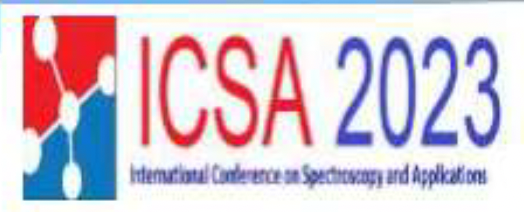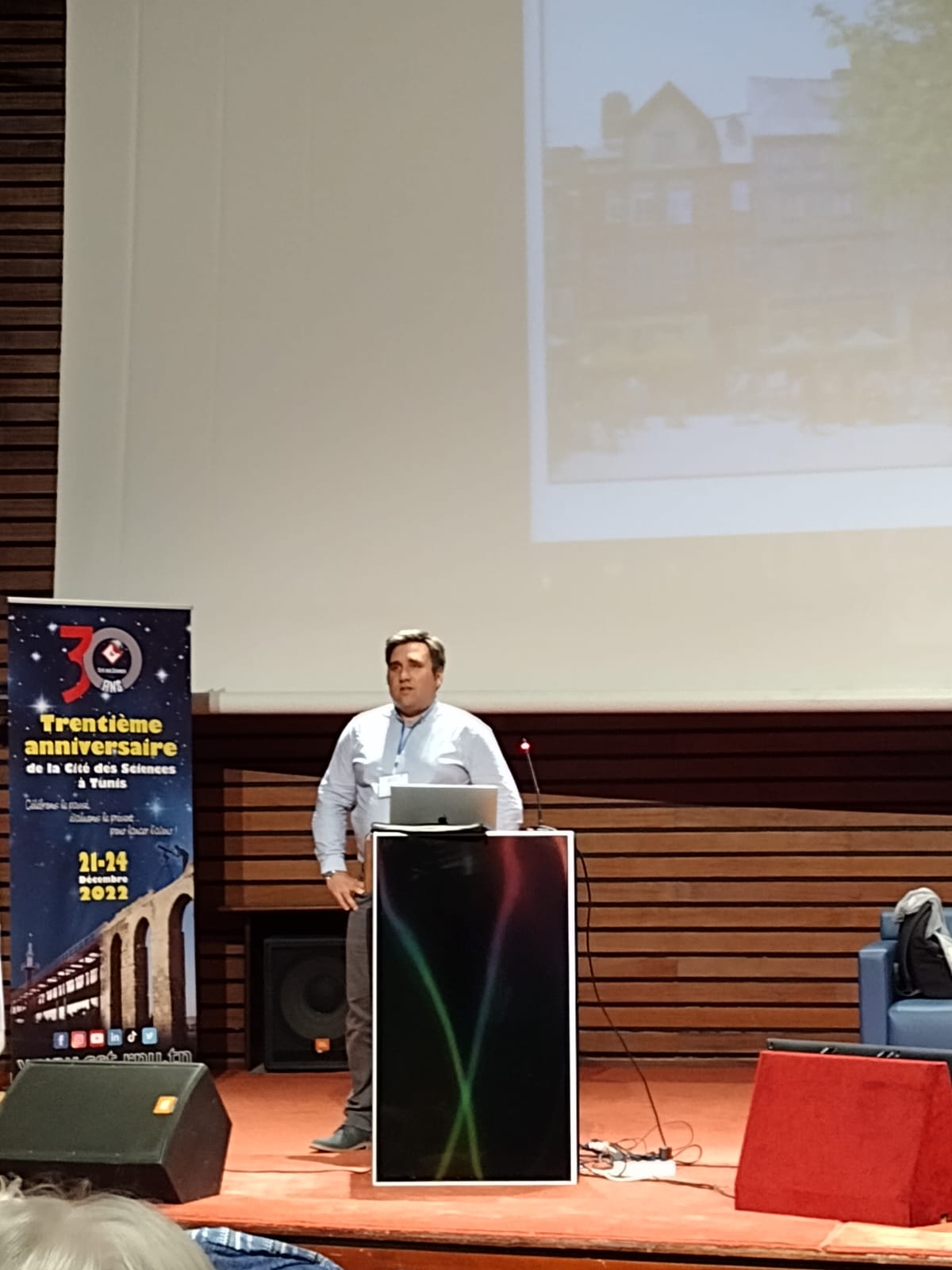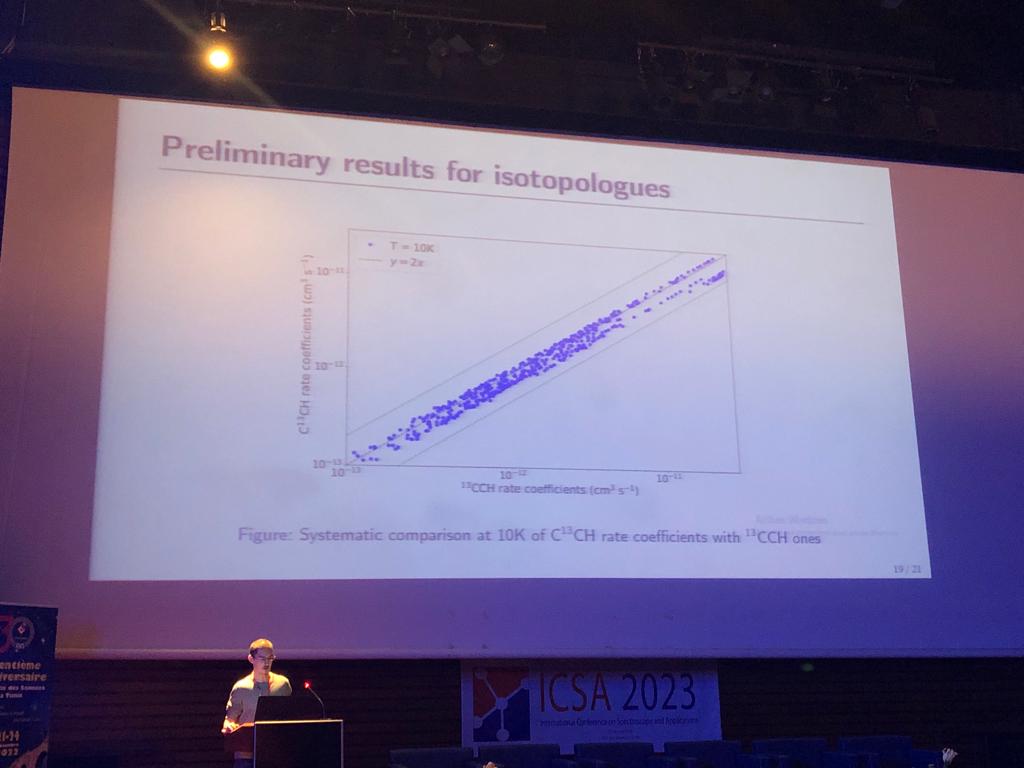by François Lique & Cheikh Bop & Paul Pirlot Jankowiak, on
Presentation of the event

The 4th International Conference on Spectroscopy and Applications (ICSA) was held in the Cité des sciences of Tunis from March 17th to 19th 2023.
The conference provides an interdisciplinary forum where physicists, chemists, biologists and industrialists may exchange recent results and promote new frontiers in the spectroscopy and applications in physics, chemistry, biology, medicine, and environments.
The event covered the following topics:
- Infrared and Raman spectroscopy
- VUV and UV- Visible spectroscopy
- Luminescence spectroscopy
- Time resolved optical spectroscopy
- X ray spectroscopy
- Nuclear spectroscopy
- NMR, EPR, and Mossbauer spectroscopy
- TeraHertz spectroscopy
- Molecular dynamics
- Impedance spectroscopy
- Theoretical methods and simulations on spectroscopy
- Applied spectroscopy : material science, Astrophysics, environment, biology, imaging, sensors, logistic, quality control, …
During this conference, F. Lique gave a plenary talk as an invited speaker.
C. T. Bop and P. Pirlot Jankowiak also presented their work in an oral communication.
The collisional excitation of interstellar ions - F. Lique
Accurate determination of physical conditions of interstellar molecular clouds is a crucial step to better understand the life cycle of the interstellar matter and particularly the formation of stars and planets as well as the synthesis of organic molecules that may lead to emergence of life in the universe. A key parameter for the determination of these conditions from interstellar spectra is the calculation of accurate collisional excitation rate coefficients of interstellar molecules with the most abundant species (H, He, H2 and e-). Whereas the knowledge of collisional processes has reached a certain level of maturity for collisions involving neutral molecules, very few reliable data exist for collisions involving ions. The computation of such data is a real challenge since inelastic and reactive processes can compete during collisions.
In this presentation, we will introduce the most recent developments that were done in the field of molecular scattering in order to overcome this complex problem and to provide collisional data for these ions in order to derive as much information as possible from the molecular spectra collected by current telescopes. In particular, as it is hardly possible to consider both collisional and reactive processes simultaneously, we will demonstrate that innovative statistical quantum mechanical methods can be used as an alternative to provide accurate data when more exact quantum calculations are not feasible.
Finally, we will also show that the new data can be efficiently used in radiative transfer models in order to derive the abundances of ions with unprecedented accuracy.

Non-LTE modeling of the HCCNC and HNCCC abundance in astrophysical environments - C. T. Bop, A. Faure, E. Quintas-Sanchez, R. Dawes, and F. Lique

The isomers of HCCCN, namely HCCNC and HNCCC, are widely observed in the interstellar medium and in circumstellar envelopes. Their abundance has been determined under the assumption of local thermodynamic equilibrium (LTE) conditions or non-LTE radiative transfer models, but considering the collisional excitation of HCCCN as the same for all isomers [1].
Chemical models for the prototypical cold cores, TMC-1 and L1544, reproduced the abundance of HCCCN fairly well, but they tend to overestimate the abundances of HCCNC and HNCCC with respect to the observations [2]. It is therefore worth revisiting the interpretation of the observational spectra of these isomers using a rigorous non-LTE modelling. The abundance of HCCNC and HNCCC were then determined using non-LTE radiative transfer calculations based on the proper rate coefficients for the first time in this work. Modeling the brightness temperature of HCCNC and HNCCC when using their proper collision rate coefficients shows that models based on LTE or non-LTE with approximate collision data may lead to deviations of up to a factor of ∼1.5 [3].
Reinterpreting the observational spectra led us to significant differences relative to the observed abundances previously determined. Our findings suggest quite similar abundance ratios for the TMC-1 and L1544 cold cores as well as the L483 protostar [4]. This work will encourage further modelling with more robust non-LTE radiative transfer calculations and future studies to revisit the chemistry of HCCCN and its isomers in cold molecular clouds.
[1]. Cernicharo, J., Marcelino, N., Agúndez, M., et al. 2020a, Astronomy & Astro-physics, 642, L8
[2]. Quénard, D., Vastel, C., Ceccarelli, C., et al. 2017, Monthly Notices of the RoyalAstronomical Society, 470, 3194
[3]. Bop, C. T., Lique, F., Faure, A., Quintas-Sánchez, E., & Dawes, R. 2021,Monthly Notices of the Royal Astronomical
Society, 501, 1911
[4]. Bop, C. T., Desrousseaux, B & Lique, F. 2022, Astronomy and Astrophysics, 662, A102
The excitation of ethynyl in the interstellar medium : A key to understand isotopic fractionation - P. Pirlot Jankowiak, P. J. Dagdigian, and F. Lique
Since the discovery of the ethynyl CCH radical in the interstellar medium [1], it has been detected in a wide range of astrophysical environments. It is one of the most abundant hydrocarbon in space and together with its detected isotopologues (CCD, 13CCH and C13CH), they are useful tracers of physical conditions. Indeed, as abundances strongly depend on the formation pathways, the measurment for the ratio [CCD]/[CCH] may constrain the age of molecular clouds in astrophysical models [2]. However, hyperfine resolved 13C-based spectra show a higher intensity in favor of C13CH lines than 13CCH ones [3, 4] whereas their formation path is supposed to be the same. It is then of high interest to investigate this apparent different abundance of the two isotopologues.
An accurate interpretation of these observations requires to determine precise rate coefficients. Such quantities are necessary for non local thermodynamic equilibrium modeling which takes into account competition between radiative and collisional processes.
Non zero nuclear spins from 13C, D and H atoms lead to a resolved hyperfine structure for these species.
Such complex energetic structure is a real theoretical challenge as exact scattering calculations are not feasible in a reasonable time. Then, it is necessary to develop numerical and methodological tools in order to determine accurate collisional data for astrophysical applications. In this study, I present the calculations of new accurate collisional data for all the CCH isotopologues.
Scattering calculations have been performed using a recoupling technique in order to determine accurate hyperfine resolved rate coefficients of CCH and its isotopologues in collision with H2. These data were derived for a large range of temperature and are expected to improve abundance ratio calculations and better understand the evolution of the isotopic fraction in astrochemical models.
[1] K. D. Tucker, M. L. Kutner, and P. Thaddeus, The Astrophysical Journal 193, 115 (1974).
[2] S. P. Trevino-Morales, P. Pilleri, A. Fuente, C. Kramer, E. Roueff, M. Gonzalez-Garcia, J. Cernicharo, M.
Gerin, J. R. Goicoechea, J. Pety, O. Berné, V. Ossenkopf, D. Ginard, S. Garcia-Burillo, J. R. Rizzo, and S.
Viti, A&A 569 (2014).
[3] S. Cuadrado, J. R. Goicoechea, P. Pilleri, J. Cernicharo, A. Fuente, and C. Joblin, A&A 575 (2015).
[4] N. Sakai, O. Saruwatari, T. Sakai, S. Takano, and S. Yamamoto, A&A 512 (2010).
